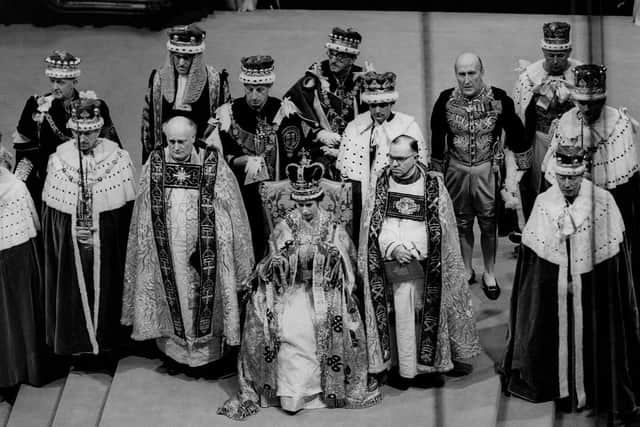21 unusual facts about Queen Elizabeth II’s coronation in 1953 including the famous food named after the ceremony
A coronation is an organised ceremony marking the official crowning and investiture of a monarch with regal power. An 11-year-old Princess Elizabeth had watched her father King George VI’s coronation in 1937, just 16 years before her own.
Her coronation took place on June 2, 1953 at Westminster Abbey, where coronations have been held for 900 years. Queen Elizabeth II’s coronation was considered a ‘ground-breaking’ event in its own right; it was the first one ever to be televised.
Advertisement
Hide AdAdvertisement
Hide AdThis would mean that the upcoming coronation of King Charles III will be the second in history to get TV coverage. We’ve taken a look at some of the lesser known facts about the coronation of Queen Elizabeth II, who died on September 8, 2022.


21 unusual and little known facts about Queen Elizabeth II’s coronation
1 - Queen Elizabeth II was in Kenya when she ascended the throne and became the first Sovereign in more than 200 years to accede while abroad.
2 - The Queen’s grandmother, Queen Mary, who was aged 81 at the time, was the first Queen to see a grandchild ascend to the throne, however, she died before the coronation was held.
3 - It is the responsibility of the Earl Marshal to organise the coronation and since 1386 the position has fallen to The Duke of Norfolk. The 16th Duke of Norfolk was responsible for The Queen’s coronation in 1953 and he was also responsible for the State funeral of Sir Winston Churchill in 1965 and the investiture of The Prince of Wales in 1969.
Advertisement
Hide AdAdvertisement
Hide Ad4 - The Queen and her husband, The Duke of Edinburgh, were driven from Buckingham Palace to Westminster Abbey in the Gold State Coach which was pulled by eight grey gelding horses: Cunningham, Tovey, Noah, Tedder, Eisenhower, Snow White, Tipperary and McCreery.
5 - The Queen’s coronation dress was designed by British fashion designer Norman Hartnell and was made of white satin and embroidered with the emblems of the United Kingdom and the Commonwealth in gold and silver thread.
6 - Since the coronation, The Queen had worn the coronation dress six times including the Opening of Parliament in New Zealand and Australia in 1954.
7 - The Queen wore the George IV State Diadem, which is shown on her head on stamps, on her way to her coronation. The crown was made in 1820 and features roses, shamrocks and thistles with 169 pearls and as many as 1,333 diamonds.
Advertisement
Hide AdAdvertisement
Hide Ad8 - 250 people were involved in the Sovereign’s procession including church leaders, Commonwealth Prime Ministers, members of the Royal Household, civil and military leaders and the Yeoman of the Guard.
9 - Prince Charles was the first child to attend his mother’s coronation as Sovereign. Princess Anne was unable to be at the ceremony as she was considered too young.
10 - Prince Charles received a special hand-painted children’s invitation to his mother’s coronation.
11 - Altogether 8,251 guests attended the coronation ceremony at Westminster Abbey.
Advertisement
Hide AdAdvertisement
Hide Ad12 - There were 129 nations and territories that were officially represented at the coronation service.
13 - There were some people in the Abbey who observed their fourth coronation. Princess Marie Louise (the granddaughter of Queen Victoria) had also seen the coronations of King Edward VII in 1902, King George V in 1911 and King George VI in 1937.
14 - There were 27 million people in the UK, out of the 36 million population, who watched the ceremony on their TV screens and 11 million people listened on the radio.
15 - The 7.2 kilometre return route was organised so that the procession could be seen by as many people in London as possible and took the 16,000 participants two hours to complete.
Advertisement
Hide AdAdvertisement
Hide Ad16 - There were many people who camped outside The Mall to view the procession, including a family who had travelled all the way from Australia in a ketch for the ceremony.
17 - The Ministry of Food approved 82 applications for people to roast oxen if they could prove that an ox had been roasted at previous coronations by tradition.
18 - The Queen wore the newly-sewn Purple Robe of Estate on the way back to Buckingham Palace; the robe’s embroidered cipher of The Queen and border of wheat ears and olive branches took 3,500 hours to complete by a team of 12 seamstresses from the Royal School of Needlework.
19 - Just under 30,000 men participated in the procession including 3,600 from the Royal Navy, 16,100 from the Army and 7,000 from the RAF, 2,000 from the Commonwealth and 500 from the ‘Colonies’. There were also 6,700 reserve and administrative troops, while 1,000 officers and men of the Royal military police were brought in to aid the Met Police. A further 7,000 police were drawn from 75 provincial forces.
Advertisement
Hide AdAdvertisement
Hide Ad20 - The Queen Salote of Tonga had captured the hearts of many crowds when she refused to raise the roof of her carriage for protection, despite the pouring rain.
21 - Before The Queen’s coronation, there was no such thing as Coronation Chicken; it was invented for the foreign guests who were to be entertained following the ceremony. The food had to be prepared in advance, and Florist Constance Spry suggested a recipe of cold chicken in a curry cream sauce with a well-seasoned dressed salad of rice, green peas and mixed herbs. She won the approval of the Minister of Works and the dish has since been known as Coronation Chicken.
Comment Guidelines
National World encourages reader discussion on our stories. User feedback, insights and back-and-forth exchanges add a rich layer of context to reporting. Please review our Community Guidelines before commenting.
